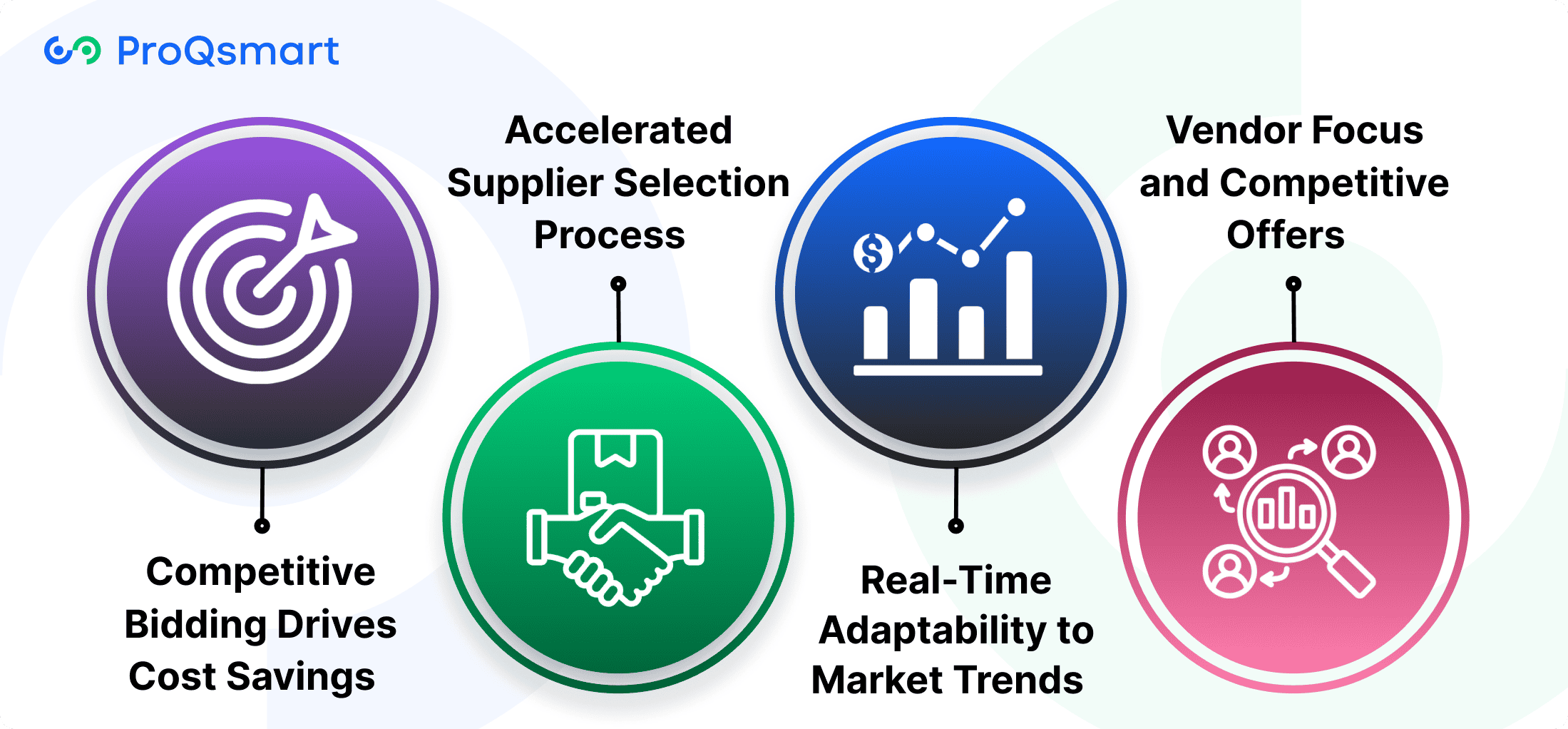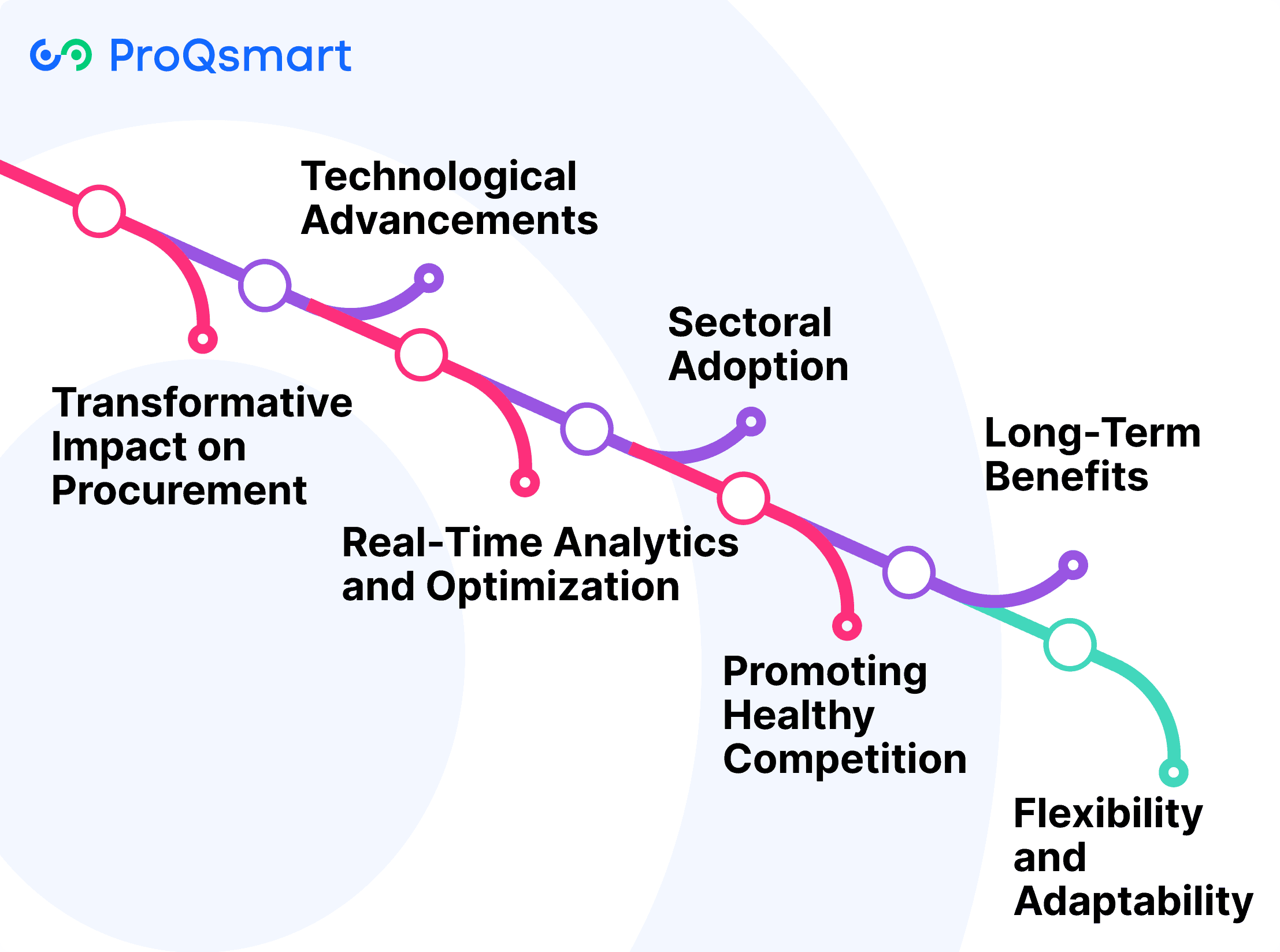Reverse auctions are a fast-moving, tactical procurement strategy in which suppliers compete against each other to submit the lowest possible price to win a contract. Unlike traditional auctions where prices rise, reverse auctions create a competitive environment where prices drop in real-time as suppliers submit progressively lower bids.
Besides increasing competition, this process increases transparency. It allows procurement professionals to spend dramatically less on cost while still getting superior quality. When employed strategically, reverse auctions give you a tactical advantage to reduce the complexity of sourcing efforts while creating competitive tension between suppliers.
Be it for direct or indirect procurement, this approach delivers value-driven purchasing without sacrificing efficiency. In this new competitive reality, putting reverse auctions to work can turn regular old procurement strategies into cost-saving, game-changing solutions.
Auction Mechanics: How Reverse Bidding Works
Reverse auctions are unique and energizing procurement competitions known for their reverse auction bidding format. Suppliers are incentivized to lower their bids even further as they compete against each other in real-time during a set bidding window. In conventional auctions, buyers outbid each other by increasing their bid amounts to acquire a good or service. In contrast, reverse auctions put suppliers in the driver’s seat and encourage them to compete primarily on price, which often leads to significant cost savings for purchasers.
Whereas, in a reverse auction to procure construction materials, many suppliers aggressively undercut each other’s bids, creating downward price pressure over a short and set period of time. This competitive dynamic is a hallmark of reverse auction procurement, where the focus shifts from the buyers to the suppliers, fostering an environment of fierce competition. The results can be quite beneficial for buyers seeking the best possible deals.
E-tendering platforms are key to facilitating these auctions. They provide a streamlined process that protects the interests of buyers while creating healthy competition among potential suppliers. Using platforms like ProQsmart, businesses can simplify the reverse auction process through features such as e-tenders for managing bids and documents, real-time collaboration tools for seamless communication, and AI-driven insights to evaluate supplier performance effectively.
Price Play: Advantages of Reverse Auctions

Reverse auctions have upended the world of procurement, creating a highly competitive marketplace where suppliers strive to offer the best value through reverse auction bidding. This cost-effective and transparent procurement method not only fosters an orderly environment but also streamlines operations for companies looking to enhance their procurement processes with reverse auction software.
Competitive Bidding Drives Cost Savings
The beauty of reverse auctions, and what makes them so powerful, is their ability to generate deep savings through the competitive pressure of bidding. Suppliers compete directly against each other by continually lowering their prices in real time in order to beat their rivals. This approach frequently yields savings of as much as 20% on total buy.
I.e., a 20% discount on high price ticket items such as industrial parts means a potential savings upwards of $100,000 a year for the average business. Of these savings, the majority aren’t theoretical – they lead to direct financial benefits that significantly improve the bottom line.
Accelerated Supplier Selection Process
Reverse auctions compress what would be months of negotiations into mere minutes. Additionally, the automated workflows and instant results make supplier selection a much simpler task for buyers, enabling them to finalize decisions faster. Platforms such as ProQsmart greatly enhance this efficiency for companies.
They enable users to organize e-tenders, simplify document processing, and integrate procurement with current budgets. This increased speed doesn’t just save time directly — it makes it easier to make sure procurement stays highly aligned with overall organizational goals.
Real-Time Adaptability to Market Trends
Reverse auctions have the unique ability to account for price trends as they happen, giving buyers the flexibility to react to changing market conditions. With this new competitive environment in their sights, suppliers focus their efforts on delivering the best possible bids that align with today’s market conditions.
This quickness to respond not only helps maintain competitive pricing, but promotes transparency and long-term supplier relationships.
Vendor Focus and Competitive Offers
Additionally, the immediate timeline associated with reverse auction procurement increases supplier competitiveness, driving them to submit their most competitive bids. The open, equitable reverse auction procedure fosters deep cooperation and respect, resulting in enduring relationships and the greatest overall value.
Auction Risks: Hurdles to Clear
Reverse auctions are a game-changing innovation in procurement auctions that realize huge savings. However, they come with challenges that require thoughtful management of the reverse auction procedure to ensure success and avoid failure. Identifying and understanding these risks is essential for procurement professionals.
Avoid Quality Dips from Low Bids
The most serious concern regarding reverse auctions is the risk that the winning supplier would cut corners on quality in order to offer the lowest bid. When suppliers aggressively lower their prices to win, it can lead to substandard materials or services that fail to meet your expectations.
For example, a supplier might offer a lower price but substitute premium-grade materials for lower-quality alternatives, impacting the final product’s durability. To address this, businesses should establish clear specifications and quality benchmarks during the auction process to ensure bids align with organizational standards.
Level the Playing Field for Smaller Vendors
Independent or smaller-scale vendors still have a hard time competing against larger suppliers using predatory pricing tactics. This imbalance can result in missed opportunities for smaller, local suppliers — especially bad news if you’re looking for more diverse sourcing options.
Platforms like ProQsmart encourage closer supplier collaboration. They build capacity inclusive for subcontractor management, guarding against favoritism and enabling equitable choice of vendors through diverse pools.
Manage Oversight During Live Auctions
Second, effective oversight will be necessary to rein in reverse auctions. Lack of oversight can lead to mistakes such as failed bids or lack of communication, derailing the auction process.
By leveraging tools such as ProQsmart’s real-time collaboration and transparency features, you can ensure operations will run smoothly and decisions will be made accurately and timely.
Prevent Supplier Distrust
Many vendors view reverse auctions as predatory, which can burn bridges and negatively impact future partnerships. Create procurement process transparency and accountability through ProQsmart’s comprehensive supplier performance monitoring.
That’s how we protect that trust and accomplish mutually beneficial outcomes for all stakeholders at auction.
ProQsmart’s Bid: Optimizing Reverse Auctions
ProQsmart’s Bid is a procurement platform digital by design and focused on optimizing reverse auctions to make them more efficient and effective. This approach is aimed at procurement professionals and the institutions they work in. It streamlines the sourcing process and cuts through contracting complexities, all while putting good government, efficiency, and transparency first.
ProQsmart automates workflows and integrates budget-driven procurement capabilities. This alignment with organizational goals is what truly makes it an indispensable tool in today’s competitive market.
Facilitating Real-Time Reverse Auctions
With ProQsmart, reverse auctions become as easy to execute as clicking a button and providing users with real-time control of the full bidding process. Powered with a user-friendly interface, it allows suppliers to submit their bids quickly and supports buyers in easily tracking and evaluating the bids.
For example, during a multi-vendor auction for a construction project, stakeholders can oversee live updates, ensuring fair competition and informed decision-making. With the platform’s real-time nature doing away with delays, procurement teams can make final sourcing decisions quicker and with more confidence.
Balancing Quality and Cost-Effectiveness
Maintaining a balance between bid quality and cost-effectiveness is critical. ProQsmart achieves this by offering tools that evaluate supplier performance and contract compliance. For instance, when sourcing subcontractors, the platform’s pre-qualification features review capabilities, ensuring vendors meet required standards.
This safeguards against solely cost-driven decisions, promoting long-term value and reliability.
Analytics for Strategic Insights
Beyond baseline analytics on what bid won, post-auction analytics provided by ProQsmart deliver actionable insights into bid performance and cost-benefit analysis. By looking at data trends, procurement teams are able to inform and create optimized future strategies.
For example, a manufacturing firm using tools like ProQsmart can identify patterns in material costs, helping refine supplier choices and budget planning. These discoveries give state and local professionals the capacity to make the most effective, data-driven decisions which are most aligned with operational goals.
Bid Smart: Tactics for Reverse Auction Success
-
Though reverse auctions are designed to lower costs, whether they’re successful depends on careful planning and implementation. To ensure optimal outcomes, consider employing the following tactics:
-
Knowing exactly what quality measures you want to achieve—and clearly defining them quality benchmarks before starting the auction—is key. Having these standards in place helps create a baseline, making sure suppliers are prioritizing value and not just price-cutting.
-
For example, in a construction procurement setting, include material specifications and performance standards clearly in the beginning. This method allows you to sift through bad bids faster and more effectively.
-
Implement tight auction windows: Reducing the time period for the bidding increases the urgency for suppliers, forcing them to submit more competitive bids. A 30-minute or 1-hour timeframe usually leads to superior outcomes.
-
It frees you from analysis paralysis and allows you to just act fast and act smart. Constant vigilance lets you guide the process in the right direction by correcting outliers or answering questions immediately.
-
Software solutions such as ProQsmart make the entire process easier,including automated workflows, AI-driven insights, and more. They allow for smooth oversight and facilitate smart, informed decision-making.
-
Well-defined auction rules, expectations, and quality requirements communicated up front will lead to better alignment among all participants. Conducting a pre-auction briefing session or publishing a comprehensive list of shaped criteria can help increase transparency, which in turn minimizes mistakes and arguments.
Auction Ahead: The Future of Cost Competition

-
Transformative Impact on Procurement: Reverse auctions are revolutionizing cost competition, efficiency, and strategic sourcing by creating a competitive environment where suppliers bid down prices, leading to significant cost savings and enhanced transparency.
-
Technological Advancements: Rapid advancements in technology, especially AI, are increasing the effectiveness of reverse auctions. AI tools predict optimal bid thresholds by analyzing historical data, market trends, and supplier behaviors, preventing budget overruns and ensuring competitive pricing.
-
Real-Time Analytics and Optimization: Platforms like ProQsmart provide real-time analytics, accelerating and optimizing auction processes. This ensures that every bid supports organizational goals and maintains fiscal discipline.
-
Sectoral Adoption: Reverse auctions are no longer limited to manufacturing or retail; they are being adopted in healthcare, construction, and public services to promote cost savings and transparency.
-
Promoting Healthy Competition: Reverse auctions foster healthy supplier competition and ensure regulatory compliance by allowing competitive bidding across various sectors.
-
Long-Term Benefits: Beyond short-term cost savings, reverse auctions provide a structured approach to spending, offering a strong framework for monitoring expenditures in real-time and maintaining fiscal control.
-
Flexibility and Adaptability: Reverse auctions allow procurement professionals to respond quickly to changing market conditions, consumer needs, and supply chain volatility, making them essential tools in the modern procurement landscape.
Conclusion
Reverse auctions introduce a new dynamic to cost competition by forcing suppliers to offer their lowest possible prices, resulting in significant cost savings and maximizing the value of every dollar spent. The transparent bidding process protects against overspending and ensures that only the most competitive suppliers secure contracts. While risks such as quality concerns and strained supplier relationships exist, they can be mitigated with smart planning and the right tools.
By leveraging platforms like ProQsmart, you can navigate these challenges effectively. Remaining adaptable, prioritizing value over cost, and maintaining healthy supplier relationships will position you for success. With the increasing availability of digital tools and data-driven insights, reverse auctions have become a powerful and effective procurement strategy.
To elevate your procurement strategy and unlock the full potential of reverse auctions, explore ProQsmart and book a demo today Discover how their innovative solutions can help you save money, enhance partnerships, and drive business success.




